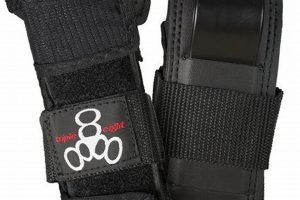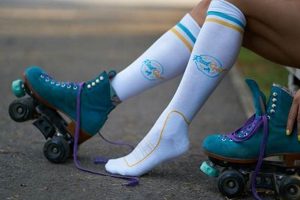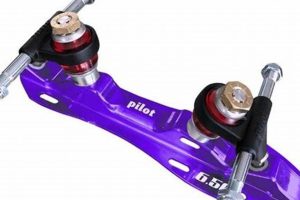Quad roller skates, a classic form of recreational footwear, are characterized by two pairs of wheels arranged in a side-by-side configuration. This design offers inherent stability, making them a popular choice for beginners and individuals seeking a comfortable skating experience. One well-known manufacturer of these skates contributed significantly to their widespread adoption and enduring appeal.
The appeal of these skates lies in their versatility. They are suitable for a wide range of activities, from leisurely gliding along paved paths to participating in roller derby or artistic skating. Their robust construction and ease of use have cemented their place in popular culture and ensured their continued relevance in the world of recreational sports. The availability of replacement parts and customization options further enhances their longevity and user satisfaction, establishing a legacy of reliable performance.
Understanding the specific attributes of these quad roller skates, including their construction materials, wheel types, and sizing considerations, is crucial for selecting the optimal pair for individual needs. Subsequent sections will delve into these aspects, providing detailed information to aid in making an informed purchasing decision and ensuring a safe and enjoyable skating experience.
Guidance for Optimal Use
The following points provide important recommendations for maximizing the lifespan and enhancing the performance of quad roller skates.
Tip 1: Wheel Maintenance: Regularly inspect and rotate wheels to ensure even wear. Uneven wear degrades performance and reduces wheel longevity. Clean wheels with a suitable solvent to remove dirt and debris.
Tip 2: Bearing Care: Periodically clean and lubricate bearings to maintain smooth rolling action. Contaminated or dry bearings increase friction and reduce speed. Use a bearing puller for safe removal and installation.
Tip 3: Tighten Components: Consistently check and tighten all nuts and bolts to prevent loosening during use. Loose components can compromise stability and lead to potential accidents.
Tip 4: Proper Storage: Store skates in a dry environment away from direct sunlight to prevent material degradation. Moisture and UV exposure can damage the boot and wheels.
Tip 5: Boot Hygiene: Clean the interior of the boot regularly to minimize odor and prevent bacterial growth. Use an antibacterial spray or wipe to maintain hygiene.
Tip 6: Surface Selection: Exercise caution when skating on abrasive surfaces. Rough surfaces accelerate wear on wheels and increase the risk of falls. Opt for smooth, paved areas whenever possible.
Tip 7: Braking Technique: Practice and refine braking techniques to ensure controlled stops. Utilize the toe stop effectively and avoid abrupt, jerky movements that can cause instability.
Adherence to these guidelines will contribute to a safer and more enjoyable skating experience, while also extending the usable life of the equipment.
Subsequent sections will address specific models and their suitability for various skill levels and skating styles.
1. Quad Configuration
The quad configuration is a defining characteristic of the type of roller skates under discussion. Its relevance to understanding the overall performance and suitability of these skates is paramount. The arrangement of two pairs of wheels, situated at the front and rear of the skate, distinguishes it from other roller skate designs and contributes significantly to its stability and maneuverability.
- Inherent Stability
The side-by-side wheel placement offers a wider base of support compared to inline skates. This configuration provides increased stability, particularly at lower speeds, making it easier for beginners to maintain balance. The stability afforded by the quad configuration allows for a more controlled learning experience, reducing the likelihood of falls.
- Maneuverability and Control
The quad configuration facilitates precise maneuvering, allowing skaters to execute turns and perform dance-like movements with greater control. The ability to easily shift weight and edges enables quick changes in direction, making these skates suitable for roller rinks, dance skating, and roller derby. The responsiveness of the quad configuration is a key factor in its appeal for activities requiring agility.
- Weight Distribution
The quad configuration distributes the skater’s weight across four points of contact, which helps to maintain equilibrium and minimize stress on individual wheels or bearings. This even weight distribution contributes to the longevity of the components and enhances the overall skating experience by providing a stable and predictable platform.
- Historical Significance
The quad configuration represents the original design of roller skates and holds historical significance in the evolution of the sport. This classic design has been refined over decades and remains a popular choice due to its inherent stability and versatility. The enduring appeal of the quad configuration is a testament to its functional design and the cultural impact of the roller skating.
The stability, maneuverability, and even weight distribution provided by the quad configuration contribute to its widespread appeal, particularly for recreational skating, roller dance, and roller derby. The arrangement ensures skaters have good equilibrium. Its enduring presence in the roller skating landscape underscores its effectiveness and its role in shaping the history of this recreational activity.
2. Wheel Durometer
Wheel durometer, measured on the Shore A scale, directly influences the performance characteristics of quad roller skates. This measurement indicates the hardness of the wheel material, typically polyurethane. Lower durometer values (e.g., 78A) signify softer wheels, offering enhanced grip and shock absorption, making them suitable for outdoor surfaces or beginners. Higher durometer values (e.g., 95A) indicate harder wheels, providing increased speed and roll efficiency on smooth, indoor surfaces. The selection of an appropriate durometer is crucial for optimizing the skating experience based on the intended environment and skill level. For example, a skater primarily using these skates on rough asphalt would benefit from the shock absorption and grip of softer wheels.
The impact of wheel durometer extends beyond simple comfort and speed. It directly affects the skater’s control and maneuverability. Softer wheels, while offering more grip, can feel sluggish at higher speeds and require more effort to maintain momentum. Conversely, harder wheels excel at maintaining speed but may lack sufficient grip on uneven surfaces, increasing the risk of slippage. This trade-off necessitates a careful evaluation of the intended use case. Artistic skaters performing intricate maneuvers often prefer a medium durometer, balancing grip and roll, while speed skaters prioritize harder wheels for maximum velocity. A specific instance would be a roller derby skater, who might prefer a wheel with a durometer between 88A and 92A, offering a balance of grip for tight turns and speed for quick accelerations.
Understanding wheel durometer is paramount for informed equipment selection. Choosing the incorrect durometer can lead to suboptimal performance and increased physical exertion. Skaters must consider the surface conditions, their skill level, and their preferred skating style when making this determination. While experimentation with different durometers is encouraged to find the optimal balance, awareness of the fundamental principles governing wheel hardness and its impact on skating dynamics is essential for a safe and enjoyable experience. The relationship ensures that the performance is at its best and the skater’s ability can shine.
3. Boot Construction
Boot construction is a critical determinant of performance, comfort, and longevity of quad roller skates. It encompasses the materials used, the manufacturing techniques employed, and the overall design of the boot. This aspect directly influences the skater’s stability, control, and protection.
- Material Composition
Boot materials range from synthetic leather to reinforced vinyl. The choice of material affects durability, support, and weight. Stiffer materials offer greater ankle support, beneficial for beginners or skaters requiring additional stability. Softer materials may provide enhanced comfort and flexibility for more advanced maneuvers. For example, a vinyl boot may offer a balance of support and affordability for recreational skaters, while a leather boot may be preferred by professionals for its durability and customizability. The interplay of these material characteristics shapes the overall boot performance.
- Ankle Support and Padding
The level of ankle support is a crucial factor in preventing injuries and maintaining control. Higher boots typically offer more ankle support, reducing the risk of sprains. Padding within the boot enhances comfort and reduces friction, preventing blisters. The design and placement of padding should conform to the foot’s contours, providing cushioning in critical areas. An inadequately padded boot can lead to discomfort and reduced skating time. A well-padded boot that can support ankle and foot in every skating movement is the best factor.
- Closure Systems
Closure systems, including laces, straps, and buckles, play a role in securing the foot within the boot. Laces allow for customized tightening across the foot, providing a snug and secure fit. Straps and buckles offer quick adjustments and additional support. The effectiveness of the closure system directly impacts the skater’s ability to control the skates and transfer power efficiently. For instance, a combination of laces and a power strap may be used to provide both a customizable fit and enhanced ankle support. There are many types of closure that provide stable closure and movement.
- Sole and Heel Construction
The construction of the sole and heel affects the skater’s balance and control. A reinforced sole provides a stable platform for mounting the skate plate, ensuring efficient energy transfer. Heel height and design influence the skater’s posture and balance. A well-designed heel can promote a more natural skating stance, reducing fatigue. The integration of the sole and heel with the overall boot structure contributes to the skate’s responsiveness and maneuverability. All factor provide the best and safest control to the user.
The boot construction is integral to the performance of skates. Material selection, ankle support, closure systems, and sole construction collectively determine the skater’s comfort, stability, and control. Understanding these aspects helps skaters make informed decisions and choose skates that meet their specific needs and preferences.
4. Bearing Precision
Bearing precision, often indicated by the ABEC rating (Annular Bearing Engineering Committee), exerts a direct influence on the performance characteristics of quad roller skates. The ABEC scale, ranging from ABEC 1 to ABEC 9, with higher numbers indicating tighter tolerances and greater precision in the bearing’s manufacturing, dictates the smoothness and efficiency of wheel rotation. In quad roller skates, higher precision bearings result in reduced friction, enabling greater speed and requiring less effort to maintain momentum. The effect is particularly noticeable during sustained gliding and longer skating sessions. Conversely, lower precision bearings introduce more friction, reducing speed and increasing the energy expenditure required for propulsion. For example, a quad skate equipped with ABEC 7 bearings will generally exhibit a smoother and faster roll compared to an identical skate fitted with ABEC 3 bearings, assuming all other factors, such as wheel durometer and bearing lubrication, are equal.
The practical significance of understanding bearing precision extends to the selection and maintenance of quad roller skates. Skaters prioritizing speed and efficiency, such as those participating in roller derby or speed skating, often opt for skates with higher ABEC-rated bearings. These bearings, while potentially more expensive, offer a performance advantage. Conversely, recreational skaters or beginners may find that lower ABEC-rated bearings provide adequate performance for their needs, offering a cost-effective solution. Regular maintenance, including cleaning and lubrication, is crucial for preserving bearing precision and maximizing their lifespan. Contaminants, such as dirt and grit, can degrade bearing performance, regardless of the ABEC rating. Proper lubrication reduces friction and protects the bearing components from wear. Failing to maintain bearings will lead to a loss of performance.
In summary, bearing precision is a critical factor influencing the performance of quad roller skates. While higher ABEC ratings generally correlate with improved speed and efficiency, the choice of bearing precision should align with the skater’s individual needs and skating style. Proper maintenance is essential for preserving bearing performance and maximizing their lifespan. A skater who is focused on the maintenance and performance will be much more happy with skates.
5. Toe Stop Adjustability
Toe stop adjustability represents a critical design element directly influencing the safety, control, and versatility of quad roller skates. As a prominent and longstanding manufacturer of these skates, the brand in question has historically incorporated adjustable toe stops to accommodate a range of skating styles and skill levels. This adjustability allows users to customize the height of the toe stop relative to the wheels, thereby modulating braking force and facilitating various maneuvers. A higher toe stop provides greater braking leverage for beginners, while a lower setting enables more advanced skaters to execute spins and other intricate movements without unintended contact with the skating surface.
The practical significance of toe stop adjustability is evident in several scenarios. For novice skaters, the ability to raise the toe stop provides enhanced stopping power, promoting confidence and reducing the risk of falls. Conversely, experienced skaters often lower or even remove the toe stops entirely to optimize their performance in activities such as roller derby or artistic skating. The adjustability feature allows for a seamless transition between different skating disciplines, effectively transforming a single pair of skates into a multi-purpose tool. Furthermore, toe stop adjustability permits compensation for wear and tear, as the toe stops gradually erode with use, necessitating periodic adjustments to maintain optimal braking performance. It allows the user to customize their experience.
In conclusion, toe stop adjustability is an essential feature that enhances the functionality and user experience of quad roller skates, with particular relevance to the models produced by the manufacturer in question. This adaptability caters to a diverse spectrum of skaters, from beginners seeking enhanced safety to advanced practitioners demanding precision and control. The ongoing refinement of toe stop adjustment mechanisms reflects a commitment to both safety and performance, underscoring the enduring importance of this seemingly simple yet highly impactful design element.
6. Plate Material
The plate material forms the foundation of quad roller skates, serving as the crucial link between the boot and the wheels. Within the context of these skates, the plate material’s characteristics directly influence the skate’s weight, durability, and responsiveness. Typical materials include aluminum alloys, nylon, and composite polymers. Aluminum alloys offer a favorable strength-to-weight ratio, contributing to agility and power transfer. Nylon plates provide a cost-effective alternative, often favored for recreational use due to their shock-absorbing properties. Composite polymers represent a more recent advancement, combining the benefits of strength and vibration damping. A cracked plate renders the skates unusable, underscoring the importance of its structural integrity.
The choice of plate material significantly impacts the skate’s handling and performance. For instance, a high-performance skater might select aluminum plates for their enhanced responsiveness and rigidity, enabling precise turns and efficient power transfer. Conversely, a recreational skater might prioritize the comfort and affordability of nylon plates. The connection between plate material and overall skate quality is evident in competitive roller derby, where skaters often upgrade to aluminum plates to gain a competitive edge in maneuverability and acceleration. Similarly, in artistic skating, the plate material’s stiffness influences the skater’s ability to execute jumps and spins with precision. The plate material provides a basis for the boot.
Ultimately, understanding the properties of different plate materials is essential for selecting quad roller skates appropriate for a specific purpose and skill level. A durable and well-matched plate material ensures both a safe and enjoyable skating experience, directly affecting the skater’s control and comfort. Plate material can affect skaters, if the plate material is wrong for skater or the skate is broken.
Frequently Asked Questions About Quad Roller Skates
The following questions address common concerns and provide factual information regarding quad roller skates, focusing on characteristics relevant to quality, safety, and performance.
Question 1: What is the typical lifespan of quad roller skates?
The lifespan of quad roller skates varies depending on usage frequency, skating environment, and maintenance practices. With regular use and proper care, a quality pair of quad roller skates can last several years. Neglecting maintenance or subjecting the skates to harsh conditions may shorten their lifespan.
Question 2: What safety gear is recommended when using quad roller skates?
Essential safety gear includes a helmet, wrist guards, elbow pads, and knee pads. Protective gear mitigates the risk of injury in the event of a fall or collision. It is advisable to wear appropriate safety gear at all times, regardless of skill level.
Question 3: How does wheel durometer affect skating performance?
Wheel durometer, measured on the Shore A scale, indicates wheel hardness. Softer wheels (lower durometer) offer increased grip and shock absorption, suitable for outdoor surfaces. Harder wheels (higher durometer) provide greater speed and roll efficiency on smooth, indoor surfaces. Wheel durometer selection should align with the intended skating environment.
Question 4: How frequently should quad roller skate bearings be cleaned and lubricated?
Bearing cleaning and lubrication frequency depends on usage and environmental conditions. Under typical conditions, bearings should be cleaned and lubricated every one to three months. Skating in dusty or wet environments may necessitate more frequent maintenance.
Question 5: What are the key indicators of worn or damaged quad roller skate components?
Indicators of worn components include excessive wheel wear, loose bearings, cracked plates, and damaged toe stops. Regular inspection is crucial for identifying and addressing these issues promptly. Ignoring worn components can compromise safety and performance.
Question 6: Are quad roller skates suitable for both indoor and outdoor use?
Quad roller skates can be used both indoors and outdoors, but the optimal wheel type varies. Softer wheels are generally preferred for outdoor surfaces due to their enhanced grip and shock absorption. Harder wheels excel on smooth, indoor surfaces. Wheel selection should be adapted to the specific environment.
The preceding answers provide essential information regarding quad roller skates. Adhering to safety guidelines and maintaining equipment properly enhances the overall skating experience and extends the life of the skates.
The subsequent section will cover advanced techniques and tips for quad roller skating.
Quad Roller Skates
This exploration has detailed the various facets of quad roller skates, from foundational aspects such as wheel configuration and durometer to more nuanced considerations including boot construction, bearing precision, and plate material. The design elements contribute significantly to the skater’s experience, affecting both safety and performance. Maintenance protocols and informed component selection are crucial for prolonging the lifespan of these skates and ensuring optimal operation.
The enduring appeal of quad roller skates reflects a synthesis of practicality and enjoyment. Continued technological advancements, focusing on materials and design, promise to further enhance their functionality and accessibility. Awareness of construction, correct usage, and appropriate maintenance is vital to extracting maximum utility and enjoyment from these classic recreational devices, ensuring their continued relevance for generations to come.







